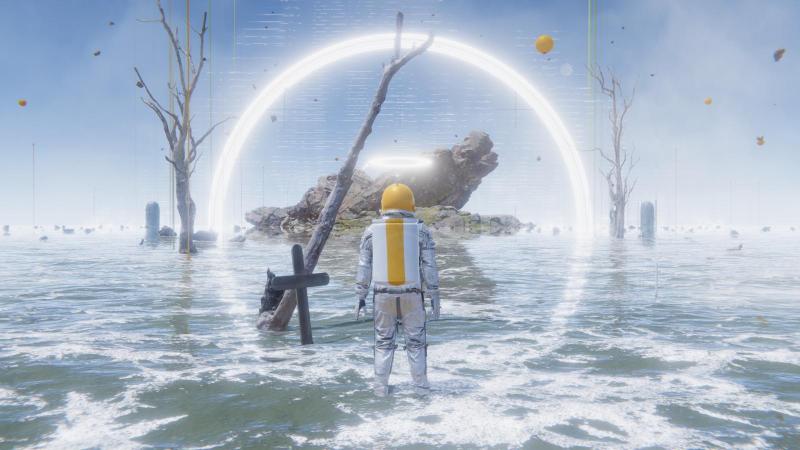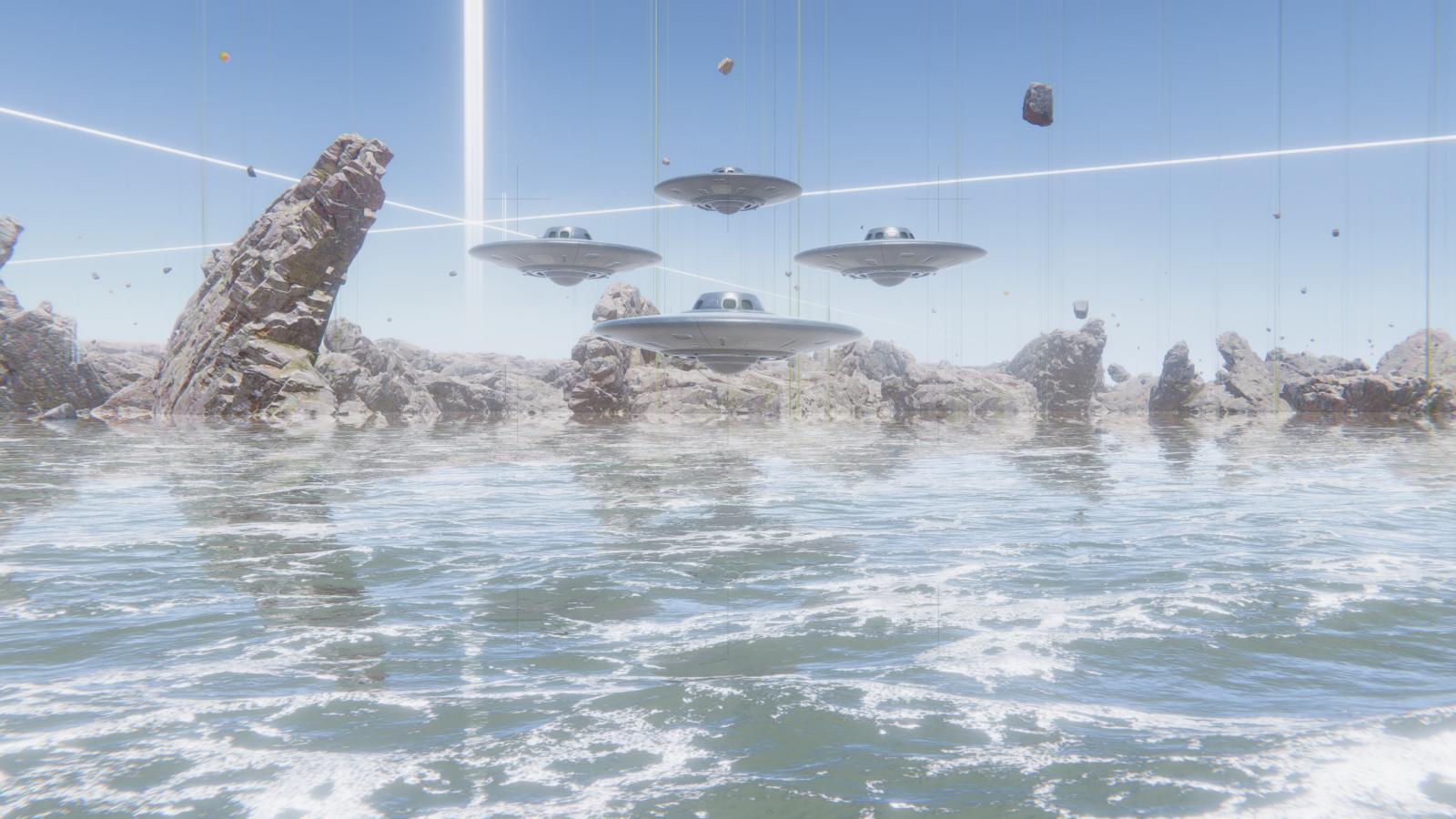Topic
You have to have an open mind to play my game – says the author of the successful video game afterglitch

Paintings by Zdeněk Burian, Salvador Dalí, or books on quantum physics – all of these inspired Vladimír Kudělka in creating the video game Afterglitch. The FFA graduate worked on its development entirely on his own for 7 years. And it paid off. The experimental video game set in space received two nominations at the International Independent Games Festival in San Francisco, USA – Best Visual Art and Most Innovative Game.
"It is a very prestigious festival, often compared to the Oscars of the independent gaming scene. For me, it was confirmation that I did it right," says Vladimír Kudělka, who attended the event on 22 March. "Even though I didn't win, I was sitting next to some of the most significant figures in the global gaming industry, such as John Romero or Shuhei Yoshida, who were watching my game. As part of the nomination, I also had the opportunity to have a booth at the world’s largest game development conference – the Game Developers Conference, which was attended by around 28,000 people," says the artist.
This was not the first award for Kudělka – in 2015, the fresh graduate of the Multimedia Studio received the Czech Game of the Year award in the Artistic Contribution to Czech Game Development category. In his work, he has long attempted to disrupt stereotypes in both the visual processing of video games and their level design.
What was specific about your very first game, Rememoried?
It was an art game about memories and dreams. Very provocative for the mainstream. I played with the mechanics that when a person looked somewhere and turned their gaze away, the whole scene changed. Just like the fading of memories. When I make a computer game, I approach it more as an artist than as a developer. I compose the scene as if I were painting a picture. Once it reaches a quality that I would hang on the wall, I start dealing with animating the image and interactivity. This is how all my games strangely come into being. The overall gameplay – or playability – is somewhat overshadowed in favour of aesthetics.
It was the aesthetics of the game Afterglitch that the professional jury appreciated. Did any works of art influence your visual style?
Yes, there were two paintings. The first is the utopian illustration by Zdeněk Burian from 1955. It depicts a little astronaut standing in front of a mass into which another figure is immersed. I couldn't get that illustration out of my head, so the first draft was in black and white. It led me to delve into questions of the fourth dimension and quantum theory. I read a lot of interesting books. One sees that even physicists and very rational people start turning to God at a certain stage in life. I became interested in the intersections of philosophy and science.
The second painting that strongly resonated with me was Corpus Hypercubus by Salvador Dalí. It has an incredible atmosphere. A lot of references to this painting appear in the game itself. That was my biggest inspiration.
You were nominated in two categories – Best Visual Art and Most Innovative Game. Which nomination are you more pleased with?
The innovation category, there are titles that no one has ever heard of and they push the boundaries of games where no one has ever seen them. I really appreciate that, and if I won this category, it would be confirmation that I made a very strange game. But I was happiest with the nomination for visual processing. Visuals were a priority for me, but over the years, I was starting to doubt if it was good. I am very happy that I now have quality confirmed with a stamp.
How does your audience differ from players of classic games like GTA?
I actually don't know, but my games are diametrically different. I think it's more people in their 30s and 40s who are no longer interested in playing shooting titles. The older generation grew up on them, but they are bored with them now. Moreover, as people age, they may contemplate more, think about death and the meaning of life. So I tried to create a game that would be similar to an art film.
You disrupt stereotypes not only in the visual processing but also in the design of the game itself. Try to describe how.
Mainstream games are built in a certain way – they have levels, you walk through corridors, you have to kill someone, or solve a quest. That's not at all the case in my games. For example, in Afterglitch, you are an astronaut on a planet and you have no instructions on what to do. You have to figure everything out yourself. And as you progress through the game, you immerse yourself into fragments and images. The game is more about feeling than pure playability. You have to have an open mind to be able to play and want to finish the game.
I'm trying to imagine it.
It's exploratory science fiction. A walk of an astronaut moving through the fourth dimension and parallel worlds that are beginning to fall apart. It goes as far as religious themes and transcendence.
What led you to turn to philosophical themes in your games?
Good question. After releasing the first art game, I noticed that mainstream titles have a greater reach. And I regretted a bit that I went too far in the artistic direction. After all, I've been taught from school to provoke and not be part of the flow. That's why with Afterglitch I thought I'd be more mainstream. I chose an astronaut on a planet, which is a relatively graspable concept. I developed the game for three years and kept redoing it. I made four versions and wasn't happy with any of them. I had a creative crisis.
Only when I discarded the effort to please the majority or appeal to them did it break. I started doing it my way regardless of the numbers and forecasts of the gaming market. That's when the breakthrough came and I was able to finish the game.
The development of the game took 7 years. Was that the only work you were involved in?
Yes, unfortunately, it was a full-time job. The first title paid for the development for all that time. I realised it wasn't entirely rational, but I worked on developing Afterglitch as long as it was possible. So in the end, it was seven years. I would not recommend such a business strategy to graduates.
In 2015, I would probably tell everyone – come and make independent games. But back then, three games were released daily; today, thirty come out. You can easily get lost. And if you don't master marketing perfectly, you probably won’t succeed. Today, it's very difficult to make a living from game development. You have to strategize whether to go to consoles and which ones, whether it can be played on a mobile phone. The market is flooded and uncertain. You can easily burn out.
What will you embark on now? Will you develop another game?
I'm at a career crossroads. I'm planning a virtual reality startup that will have overlap into wellness & fitness. And I could get an investor. I wanted to take a break from game programming because seven years was a long time. And in the future, I would like to deal with more certain things and not bet everything on one card. But the IGF nomination messed it up a bit for me. I got the taste again and a lot of ideas.
(mar)
She designed a board game from the gothic universe, now a graduate of a FFA is motivating other game developers
We are probably wouldn't recognize ancestors from prehistoric times on the street, says sculptor Ondřej Bílek
It's an opportunity to bring art to people, says a graduate of FFA BUT, whose work comes to life in ČT art jingles
Women from BUT who move the world of science and technology
An educational computer game about the position of Roma in society scored in the Czech technology agency’s Sigma programme

